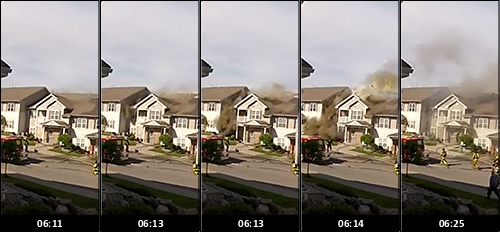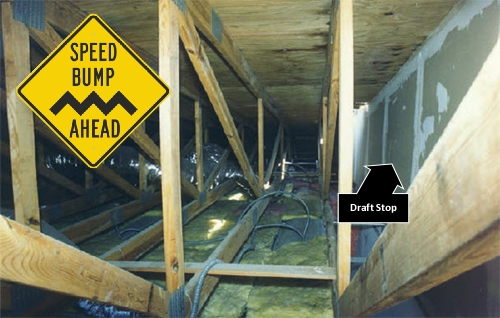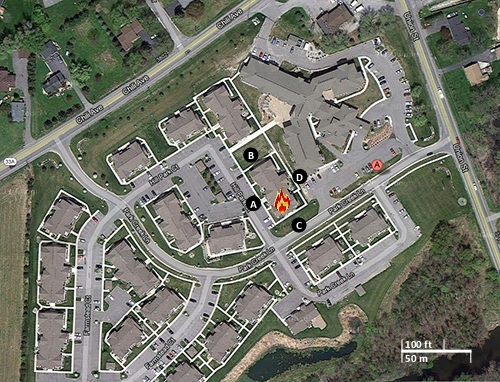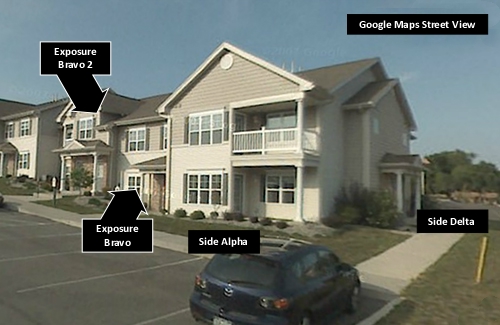Smoke is Fuel: Recognizing the Hazard
There has been an increasing awareness that smoke is fuel and that hot smoke overhead results in thermal insult (due to radiant heat transfer) and potential for ignition. However, the hazard presented by smoke as gas phase fuel can extend a considerable distance from the current area of fire involvement.
Reading the Fire
Print a copy of the B-SAHF Worksheet. Use the worksheet to document observed fire behavior indicators as you watch the first six minutes of the following video of an apartment fire that occurred on May 10, 2013 at the corner of Park Creek Lane and Hill Park Court in Churchville, NY. In particular, focus on fire behavior indicators that may point to changes in conditions. Don’t focus too much on the flame indicators presenting from the area involved, but pay particular attention to Building, Smoke, and Air Track indicators.
The following satellite photo and view of the Alpha/Delta Corner prior to the fire are provided to help orient you to the incident location. You can also go to Google Maps Street View and do a walk around on Sides Alpha (Hill Park Court) and Delta (Park Creek Lane) to view all four sides of the building.
The following time sequence from the video of this incident illustrates the conditions immediately prior to and during the explosion. The extremely rapid increase in heat release rate during the explosion was not sustained (a transient event) as evidenced by conditions illustrated at 06:25.

Building Factors
This building is of Type V construction with a wood truss roof system. In a large apartment building such as this, the trussloft is typically subdivided with draft stops comprised of gypsum board applied to one (or both) sides of a truss to stop rapid spread of fire within the trussloft. Draft stops should be thought of as speed bumps rather than a barrier (such as a firewall that extends through the roofline). While draft stops slow fire and smoke spread, they do not stop it completely and it is common for smoke to spread beyond the fire area despite the presence of draft stops.

The small dimension framing materials used in truss construction have a high surface to mass ratio, increasing the speed with which they can be heated and increasing pyrolysis products in the smoke when heated under ventilation limited conditions.

Note: The possible location of the draft stops is speculative as specific information regarding the construction of this building was not available at the time of this post. However, draft stops may be provided between the trussloft between units or based on the size of the trussloft without regard to the location of walls between units. Preplan inspections provide an opportunity to examine building factors that may be critical during an incident!
Smoke and Air Track Indicators
An important air track indicator in this incident was the strong wind blowing from the Alpha/Bravo Corner towards the Charlie/Delta Corner. The wind may have had some influence on ventilation in the trussloft above Exposures Bravo and Bravo 2, and definitively influenced other Smoke and Air Track indicators.
From the start of the video light colored smoke is visible at the peak of the roof above Exposure Bravo and Bravo 2, indicating that smoke had infiltrated areas of the trussloft that had not yet become involved in fire. Smoke that is light in color may be comprised of pyrolysis products and air and may be to lean or too rich to burn or it may be explosive See the video Smoke on the Firegear website for a good discussion of the characteristics of smoke (note that this video is currently undergoing validation).
The volume and color (smoke indicators), velocity and direction (air track indicators) above exposure Bravo 2 vary considerably from the start of the video until shortly before the explosion that occurred at 06:12 in the video. At 02:52 a firefighter entered Exposure Bravo 2 and a short time later at 03:47 a hoseline (dry) was stretched into this exposure and charged. It is unknown from watching the video if the firefighters on this line advanced to Floor 2 or if they took any action to change the ventilation profile (other than opening the door on Floor 1, Side Alpha). The exited after the explosion, but without haste, so it is likely that they were not on Floor 2 at the time of the explosion.
Smoke Explosion
Smoke explosion is described in a number of fire dynamics texts including Enclosure Fire Dynamics (Karlsson and Quintiere) and An Introduction to Fire Dynamics (Drysdale). However, Enclosure Fires by Swedish Fire Protection Engineer Lars-Göran Bengtsson (2001) provides the most detailed explanation of this phenomenon. Paraphrasing this explanation:
A smoke or fire gas explosion occurs when unburned pyrolysis products and flammable products of combustion accumulate and mix with air, forming a flammable mixture and introduction of a source of ignition results in a violent explosion of the pre-mixed fuel gases and air. This phenomenon generally occurs remote from the fire (as in an attached exposure) or after fire control.
In some cases, the fire serves as a source of ignition as it extends into the void or compartment containing the flammable mixture of smoke (fuel) and air.
Conditions Required for a Smoke Explosion
The risk of a smoke explosion is greatest in compartments or void spaces adjacent to, but not yet involved in fire. Infiltration of smoke through void spaces or other conduits can result in a well-mixed volume of smoke (fuel) and air. Smoke explosion creates a significant overpressure as the fuel and air are premixed and ignition results in a very large energy release. Several factors influence the violence of this type of explosion:
- The degree of confinement (more confinement results in increased overpressure)
- Mass of premixed fuel and air within the flammable range (more premixed fuel results in a larger energy release)
- How close the mixture is to a stoichiometric concentration (the closer to an ideal mixture the faster the deflagration)
Potential Smoke Explosion Indicators
It is very difficult to predict a smoke explosion. However, the following indicators point to the potential for this phenomenon to occur:
- Ventilation controlled fire (inefficient combustion producing substantial amounts of unburned pyrolysis products and flammable products of incomplete combustion)
- Relatively cool (generally less than 600o C or 1112o F) smoke
- Presence of void spaces, particularly if they are interconnected
- Combustible structural elements
- Infiltration of significant amounts of smoke into uninvolved compartments in the fire building or into exposures
Preventing a Smoke Explosion
As it is difficult to predict a smoke explosion, there are challenges to preventing their occurrence as well. However, general strategies would include 1) preventing smoke from accumulating in uninvolved spaces or 2) removing smoke that has accumulated remote from the fire (e.g., in attached exposures), or 3) a combination of the first two approaches.
Tactics to implement these strategies may include:
- Pressurizing uninvolved spaces with a blower to prevent infiltration of smoke. This involves use of a blower for anti-ventilation by applying pressure without creating an exhaust, similar to what is done to pressurize a highrise stairwell. It is essential to check for extension prior to implementing this tactic!.
- Horizontal ventilation of attached exposures to remove smoke, checking for extension, and then pressurization with a blower to prevent continued infiltration of smoke. If fire extension is found, pressurization without an exhaust opening must not be implemented!
Additional Resources
The following previous posts on the CFBT-US Blog may also be of interest in exploring the smoke explosion phenomena.
- Smoke Explosion or Backdraft
- Fire Gas Ignitions
- Language and Understanding: Extreme Fire Behavior
- Extreme Fire Behavior: An Organizational Scheme (Ontology)
- Gas Explosions
- Sudden Blast
- Explosions During Structural Firefighting
References
Bengtsson, L. (2001). Enclosure Fires. Retrieved May 12, 2013 from https://www.msb.se/RibData/Filer/pdf/20782.pdf .
Tags: B-SAHF, Extreme Fire Behavior, FBI, fire behavior indicators, smoke explosion




